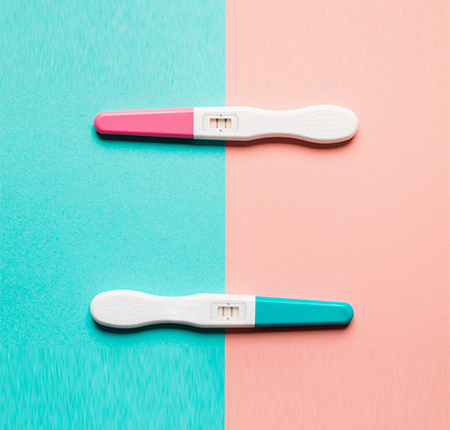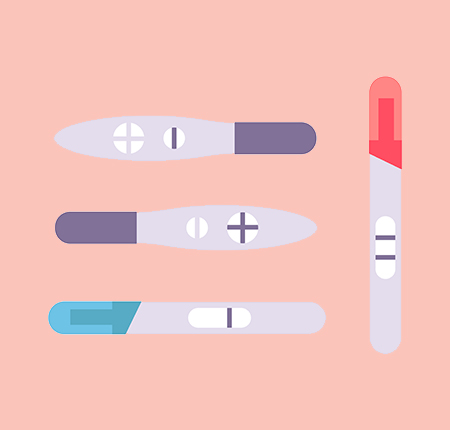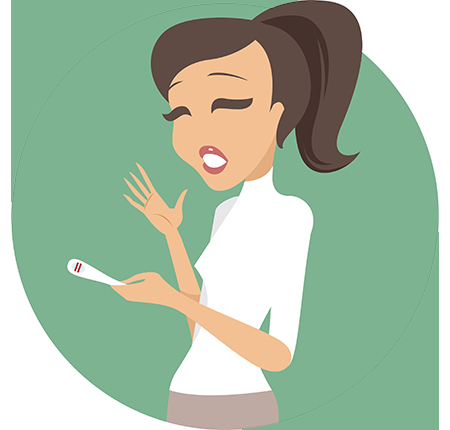
Un test de sarcină poate fi un motiv de anxietate: dacă menstruația ta întârzie și nu te-ai protejat ultima dată când ai făcut sex, deși nu îți dorești o sarcină. Sau poate e a doua oară când aștepți un rezultat pozitiv! În orice caz, ce e de făcut? Când poți face un test de sarcină? Cum îl interpretezi și câtă încredere poți să ai în rezultat? Vorbim despre toate în acest articol!
Testul de sarcina - Ce este si cum functioneaza?
Majoritatea testelor de sarcină funcționează pe baza acelorași principii, iar toate variantele pe care le găsești în farmacii au instrucțiunile scrise - pe care îți recomandăm să le citești cu atenție.
Principul de bază pentru majoritatea testelor este simplu și același: testele de sarcină detectează gonadotropina corionică umană (hCG) în urină. Testele se fac acasă, rapid și ușor.

Cand este cazul sa faci un test de sarcina?
Poți face un test de sarcină începând cu prima zi în care ți-a întârziat menstruația, iar dacă nu ești sigură când ar trebui să fii la menstră, e recomandat să-l faci la cel puțin 21 de zile de la un contact sexual neprotejat. E bine de știut faptul că unele teste pot fi folosite chiar și înainte de menstruație și mai ales, fiecare persoană poate avea simptome diferite.
Iată câteva din primele simptome comune de sarcină:
- Crampe abdominale. Atunci când un ovul fertilizat se atașează peretelui uterin, poți simți crampe.
- Spotting. Poate fi sangerarea de implantare și poate să apară de la 6 până la 12 zile de la fertilizarea ovulului.
- Secreții vaginale de culoare albă. Imediat după concepție, pereții vaginului vor începe să se îngroașe, iar corpul va produce o secreție specifică.
- Sâni umflați, dureroși. Schimbările la nivelul sânilor apar foarte devreme în sarcină, din cauza modificării hormonilor, iar culoarea din jurul sfârcurilor poate deveni mai închisă.
- Nivel crescut de oboseală, mai mult decât de obicei. Poate fi din cauza hormonilor (progesteronul crește), sau a scăderii tensiunii arteriale și producției crescute de sânge.
- Fără menstruație. Cel mai comun simptom al unei sarcini este întârzierea menstrei, deși un ciclu fără menstruație nu e întotdeauna un semn al sarcinii.
- Greață. În special când apare dimineața, poate fi un semn timpuriu al unei sarcini, deși nu este valabil pentru toate persoanele.
- Alte semne pot fi: urinarea frecventă, constipația, schimbările de dispoziție, amețeli, dureri de cap, dureri musculare în special în zona spatelui.
Nu toate persoanele trec prin aceleași simptome în sarcina timpurie. În plus, s-ar putea să nu faci deosebirea între semnele unei sarcini și simptomele premenstruale, pentru că de multe ori sunt asemănătoare.
Cat costa un test de sarcina si de unde il pot achizitiona?
Dar dacă observi câteva simptome din cele de mai sus și vrei să afli dacă ești însărcinată, e momentul să achiziționezi un test de sarcină. De unde îl poți cumpăra și care e prețul unui test de sarcină? Poți achiziționa un test de sarcină online, atât din farmacii online cât și de pe alte site-uri și magazine online. De asemenea, îl găsești și în locațiile farmaciilor fizice. Cât costă un test de sarcină diferă în funcție de brand, de tipul testului și desigur, de farmacia sau magazinul de unde alegi să îl cumperi. Dar deși prețurile variază între 10 - 70 lei, în general nu vei plăti mai mult de 25-35 de lei pentru un test obișnuit.
Așa că vestea bună este că testele de sarcină sunt foarte accesibile. Le poți cumpăra fără a fi nevoie de o rețetă, fără un efort financiar ridicat ținând cont de cât costă un test de sarcină, și le poți efectua atât acasă cât și într-un centru medical supervizat sau într-o clinică.
Poți achiziționa un test de sarcină online, pe platforme precum emag sau farmacii online. De asemenea, le găsești în orice farmacie. Poți face un test de sarcină supervizat într-un centru medical sau o clinică. Prețurile variază între 10 - 70 lei, iar testele se cumpără fără a fi nevoie de o rețetă.
Cum se face un test de sarcina?
Cele mai multe teste de sarcină sunt foarte ușor de folosit. Acestea au fie un capăt absorbant, fie o fantă pentru colectarea urinei.
În funcție de design-ul testului, interpretarea poate să difere. Fiecare test are un interval de timp în care trebuie citit pentru ca rezultatul sa fie corect. Așadar, în majoritatea cazurilor, citirea se poate face după 5 sau 10 minute, iar modificările după 10 minute nefiind relevante. Însă nu-ți face griji, vei găsi toate aceste instrucțiuni în cutia testului pe care îl achiziționezi.
Acest rezultat poate să apară fie sub forma semnelor + sau -, fie ca o modificare a culorii sau apariția unor linii.

Ce este hormonul hCG sau beta-hCG?
hCG este un hormon produs de placentă. Acesta poate ajuta foliculii să se maturizeze și să declanșeze ovulația, iar cu ajutorul acestui hormon, un test de sarcină va determina dacă ești sau nu însărcinată.
Hormonul hCG sau beta-hCG poate să apară la 6-10 zile de la implantarea ovulului fecundat: un nivel de hCG mai mic de 5mlU/ml va însemna un rezultat negativ, iar un nivel HCG >= 35mlU/ml înseamnă o sarcină.
Rezultat sarcina - Cum arata un test de sarcina pozitiv?
Înainte să faci un test, trebuie să reții faptul că rezultatul poate fi influențat de modul în care îl faci și momentul zilei (cel mai indicat este dimineața la prima oră după trezire). Nu este exclus să apară erori în rezultat.
Așadar, cum citești rezultatul unui test de sarcină?
Majoritatea testelor vor afișa două liniuțe roșii (C + T), indicând astfel un rezultat pozitiv.
Putem lua, spre exemplu, un test Barza.
- O singură linie roz în poziția 1 indică faptul că nivelul hCG este între 25mIU/ml și 100mIU/ml, concentrație care apare atunci când ai sarcina de până la 2 săptămâni
- Două linii roz în pozițiile 1 și 2 indică nivelul hCG între 100mIU/ml și 300mIU/ml. Apare la trei săptămâni de sarcină.
- 3 linii roz în pozițiile 1, 2 și 3 înseamnă până la 4 săptămâni de sarcină
- 4 linii roz indică mai mult de 4 săptămâni de sarcină
- Iar dacă nu apare nicio linie în zona C, rezultatul este invalid.
Ce poate duce la un rezultat fals pozitiv?
În unele cazuri rare, poți să ai un rezultat fals pozitiv, atunci când:
- Ai avut o sarcină recentă, după un avort spontan sau o întrerupere de sarcină
- Ai forme rare de chisturi ovariene
- Folosești anumite medicamente care conțin hormonul hCG - tratamente de fertilitate
Rezultat Negativ Test de Sarcina
Rezultatul negativ va fi indicat de linia roz doar în zona C.
Ce poate duce la un rezultat fals negativ?
Însă există o probabilitate să obții un rezultat fals negativ, ceea ce e mai frecvent decât în cazul rezultatului fals pozitiv. Dacă nu ești sigură că rezultatul testului este corect, cel mai bine e să te adresezi unei clinici.
Rezultat Invalid
Atunci când prima linie nu apare sau apare doar în dreptul simbolului T, înseamnă că testul de sarcină este invalid și va trebui să-l repeți.
Cat de sigur este un test de sarcina?
Deși majoritatea testelor promit că oferă rezultate precise, sigure în proporție de 99% încă din prima zi în care ți-a întârziat menstruația, studiile arată că nu toate testele sunt atât de sigure atunci când le faci foarte devreme în sarcină. Cele mai multe se recomandă la o săptămână după întârzierea menstrei, pentru o mai mare acuratețe a rezultatului.
Erori care pot să apara când faci testul de sarcina
Șansele să apară erori când faci un test de sarcină sunt mici, dar este posibil. În general, marja de eroare a fiecărui test este înscrisă pe ambalajul acestuia, majoritatea testelor având o eficiență de 99%.
Așadar, deși rar, există posibilitatea să obții un rezultat pozitiv chiar dacă nu ești însărcinată (fals pozitiv), mai ales dacă ai fost însărcinată recent, iei anumite medicamente hormonale cum sunt cele pentru fertilitate, sau ai anumite afecțiuni precum chisturi ovariene sau adenomioză.
De asemenea, rezultatele testelor pot fi false și în urma erorii umane. Câteva dintre cele mai comune greșeli care pot duce la un rezultat eronat al testului sunt să:
- Nu verifici data de expirare și să faci un test expirat
- Faci testul prea curând după actul sexual neprotejat (poate duce la un rezultat fals negativ)
- Faci testul prea curând după un avort, după o pierdere de sarcină sau după naștere (poate duce la un rezultat fals pozitiv)
- Bei foarte multe lichide înainte de a face testul (poate dilua cantitatea de hormoni din urină)
- Iei banda de test de sub jetul de urină mai repede decât timpul recomandat
- Verifici rezultatul testului mai repede sau mai târziu decât în intervalul de timp recomandat
Pentru a evita astfel de erori, citește întotdeauna cu atenție și urmează instrucțiunile de utilizare. Ele pot fi înscrise pe ambalaj, unde uneori e trecut inclusiv cât de eficient este sau cât costă un test de sarcină, sau pot fi trecute separat pe o foaie de instrucțiuni inclusă în cutie.
A doua linie la testul de sarcina este stearsa
În general, o a doua linie pe testul de sarcină indică faptul că ești însărcinată – fie că este ștearsă sau clar definită. Însă dacă este foarte ștearsă, înseamnă că testul a detectat doar o cantitate mică de hormon hCG în urină, indicând că implantarea a avut loc și că sarcina este încă la început. Pentru a fi sigură, se recomandă să repeți testul peste câteva zile sau săptămâni. Un al doilea test pozitiv îți poate confirma rezultatul inițial, și cu cât a doua linie devine mai groasă și mai închisă la culoare, înseamnă că sarcina a continuat să se dezvolte.
Tipuri de teste de sarcina
Există mai multe tipuri de teste de sarcină pe care le poți cumpăra în farmacii și efectua acasă - și deși sunt branduri sau tipuri diferite, majoritatea funcționează la fel. Nu-ți face griji, orice test de sarcină va avea instrucțiunile scrise, pe care e recomandat să le citești atent înainte de a efectua un test. Dar hai să vedem ce tipuri de sarcină ai putea să întâlnești.
Test de sarcina tip banda
Testul tip bandă este ușor de folosit: se colectează o probă de urină într-un recipient curat, uscat, și se introduce testul cu vârful săgeții în jos, pe linia marcată, timp de câteva secunde. Apoi, testul se așează pe o suprafață plană, iar rezultatul va fi afișat după 3 minute.
Multe din testele de sarcină tip bandă detectează niveluri mici de hCG, și pot avea rezultate corecte încă din prima zi în care a întârziat menstruația. Rezultatul se interpretează în primele 5 minute, nu mai târziu.
Test de sarcina tip caseta
Testul tip casetă funcționează pe același principiu ca testul de tip bandă. Vei colecta o probă de urină într-un recipient curat și uscat, apoi, cu ajutorul unei pipete, vei colecta urina ți vei pune 3-4 picături în compartimentul testului de sarcină. Rezultatul se interpretează după 5 minute, dar nu mai târziu de 10 minute.
Test de sarcina tip stilou
Un alt tip de test care poate depista hCG în primele zile ale sarcinii este testul de sarcină tip stilou. Colectezi o probă de urină într-un recipient uscat și curat, introducă capătul absorbant pentru 3 secunde, iar după 3 minute, poți citi rezultatul. Capătul absorbant se poate introduce direct sub jetul de urină, fără a mai colecta urina într-un recipient separat.
Test de sarcina digital
E un test de sarcină mai avansat, pentru că îți poate spune cât de avansată este sarcina. Asemănător cu testul tip bandă, testul digital se introduce într-un recipient curat și uscat, în care ai colectat o probă de urină. Testul se lasă 20 de secunde, apoi se așează pe o suprafață plană timp de 3 minute, după care va indica rezultatul - iar rezultatul va rămâne afișat timp de 24 de ore.
Testele de sarcina ultrasensibile - cum functioneaza?
Testele de sarcină pot fi și ultrasensibile și pot depista nivelul hormonului hCG încă din primele zile ale sarcinii. Pot fi făcute cu 5 zile înainte să-ți întârzie menstruația, în orice moment al zilei.
Testele de sarcina la 8 zile de la conceptie
Iar dacă ești în căutarea unui test extrem de sensibil, există și variante de teste care pot detecta o sarcină la 8 zile de la concepție. Un exemplu este testul Viola Super, care poate detecta cel mai mic nivel de hCG (până la 5IU/L). Se recomandă, însă, să-l folosești dimineața, odată cu prima urină din zi.
Test de sarcina negativ la 5 saptamani
Uneori, chiar dacă există o sarcină, testele pot eșua să o detecteze – da, chiar și la 5 săptămâni. Deși este foarte puțin probabil, există posibilitatea să obții un test de sarcină negativ la 5 săptămâni dacă în urină se află o cantitate de hormon hCG insuficientă pentru a fi detectată de un test pentru acasă.
Și sarcina ectopică poate duce uneori la un rezultat negativ al testului de sarcină, dar acest lucru se întâmplă foarte rar. În general, testele pot detecta inclusiv sarcina extrauterină, care necesită imediat o vizită la medic fiindcă nu va putea fi dusă la termen și reprezintă un pericol pentru mamă.
Exista substante care pot interfera cu rezultatele testului?
Unele medicamente pot interfera cu rezultatul unui test de sarcină, în special tratamentele pentru infertilitate sau care conțin hCG. Anticoncepționalele (pilula) sau antibioticele nu influențează rezultatul unui test de sarcină.
Cu toate acestea, un rezultat fals-negativ poate apărea din diverse cauze și factori care influențează rezultatul testului, cum ar fi:
- O sarcina chimică - o pierdere de sarcină care apare la foarte scurt timp după implantare
- O sarcină ectopică - atunci când ovulul fertilizat se implantează în afara cavității principale a uterului. Dacă suspectezi o sarcină ectopică (simptomele includ dureri intensificate în zona abdomenului, sângerări abundente sau spotting sau amețeli - adresează-te medicului ginecolog.
Intrebari frecvente despre testul de sarcina:
Dupa cat timp se va vedea sarcina pe test?
Dacă îți dorești un rezultat cât mai devreme, poți opta pentru un test ultrasensibil, care poate detecta cele mai mici niveluri de hormon hCG, chiar la începutul sarcinii (la 8 zile după concepție). Însă cele mai multe teste de sarcină funcționează după prima zi în care ți-a întârziat menstruația sau prima săptămână de întârziere.
Poti face test de sarcina cand esti pe ciclu?
Da. Menstruația nu modifică rezultatul testului, iar nivelul de hCG rămâne același. Unele persoane au o sângerare asemănătoare menstruației care poate să apară în sarcină. E posibil să fie o sângerare de implantare.
Dacă sângerezi, îți recomandăm folosirea produselor menstruale organice, fără chimicale și fără plastic, pentru a avea grijă de echilibrul tău hormonal.
Testul de sarcina trebuie sa fie facut intr-o anumita parte a zilei?
Majoritatea brandurilor recomandă utilizarea lor dimineața, pentru că urina este mai concentrată. Însă dacă faci testul după o perioadă în care ți-a întârziat menstruația, poți să-l efectuezi în orice moment al zilei, pentru că deja cantitatea de hormon de sarcină e suficient de mare încât să fie detectată.
Este posibila depistarea sarcinii fara test (cu ulei/zahar)?
Pe scurt: nu.
În Egipt și Grecia antică, o metodă comună era folosirea usturoiului sau a cepei. Tot în Grecia, un test consta în consumul unui amestec de miere și apă înainte seara, iar dimineața dacă persoana avea simptome de balonare, însemna că era însărcinată.
O altă variantă era testul de ulei: într-un recipient în care s-a colectat urină, se adaugă două picături de ulei, iar dacă aceste picături se contopeau, rezultatul era pozitiv. Deși a rămas o metodă comună până târziu, nu s-a dovedi științific că este sigură.
Tot o metodă des folosită era cu ajutorul zahărului: câteva linguri de zahăr se amestecau cu urină, iar dacă lichidul devine omogen, rezultatul era pozitiv. Însă nici acest test nu este demonstrat științific.
Alte informatii - Ce urmeaza?
În funcție de rezultat, poți să plănuiești ce faci mai departe. În primul rând, dacă testul este pozitiv, programează un test suplimentar de sânge și/sau o ecografie, pentru a confirma sarcina.
Dacă testul e negativ și menstruația continuă să întârzie, poți repeta testul la câteva zile sau o săptămână, iar dacă va fi în continuare negativ - și menstruația îți întârzie și mai mult, consultă un ginecolog. Pentru că pot fi mai multe cauze pentru întârzierea menstrei, inclusiv perioade de stres intens, sport intens, tulburări hormonale.
Sarcina este dorita

Ce urmează după vizita la ginecolog? Dacă ești însărcinată și vrei să continui sarcina, poți începe îngrijirea prenatală. Ginecologul tău va calcula perioada aproximativă a nașterii și îți va recomanda vaccinurile pe care ar trebui să le faci și testele prenatale pentru a se asigura că fătul se dezvoltă sănătos.
Sarcina nu este dorita
Dacă sarcina nu este dorită, există metode de întrerupere a sarcinii. Primul pas, și în acest caz, este să vorbești cu medicul tău.

În România, întreruperea de sarcină legală, la cerere, poate fi realizată până în cea de-a 12-a săptămână de sarcină. Printre metodele de întrerupere sunt metoda farmacologică, care poate fi folosită până la 9 săptămâni de sarcină și cu condiția ca medicamentele să nu fie contraindicate, și metoda instrumentală, care se poate efectua sub anestezie locală sau totală.
Analize recomandate după un test de sarcină pozitiv
Este o idee bună să faci și un al doilea test de sarcină, pentru a fi sigură că rezultatul este corect. Iar pasul imediat următor după ce este confirmat rezultatul pozitiv este să te programezi la medicul ginecolog. Este important ca sarcina să fie monitorizată încă de la început și să efectuezi toate analizele necesare în sarcină pentru a preveni complicațiile și a te asigura că vei naște un bebeluș sănătos.
În cadrul primului consult, de obicei se face o evaluare a istoricului tău medical și un control ginecologic (pentru a detecta posibilii factori de risc), urmând ca medicul să-ți recomande mai apoi analizele standard specifice trimestrului 1 de sarcină. Acestea pot include ecografia, un sumar de urină, hemoleucograma și glicemia, stabilirea grupei de sânge și a factorului Rh și altele, pe care le vei discuta și stabili împreună cu medicul specialist.
Surse utilizate pentru redactarea articolului
Pentru a-ți oferi informațiile și răspunsurile cuprinse în acest articol, am consultat următoarele surse online:
1. Cleveland Clinic, “Pregnancy Tests”: https://my.clevelandclinic.org/health/diagnostics/9703-pregnancy-tests
2. WebMD, “Pregnancy Tests”: https://www.webmd.com/baby/pregnancy-tests
3. Healthline, “Tests Used To Confirm Pregnancy”: https://www.healthline.com/health/pregnancy/tests
4. MedicalNewsToday, “What To Know About Pregnancy Testing”: https://www.medicalnewstoday.com/articles/316463
5. Mayo Clinic, “Home pregnancy tests: Can you trust the results?”: https://www.mayoclinic.org/healthy-lifestyle/getting-pregnant/in-depth/home-pregnancy-tests/art-20047940
6. The Source: “7 Reasons Your Pregnancy Test Gave A False-Positive”: https://www.thesource.org/post/reasons-your-pregnancy-test-gave-a-false-positive
7. MedicalNewsToday, “Five reasons for false-positive pregnancy test”: https://www.medicalnewstoday.com/articles/319803
8. Healthline, “Causes of a Negative Pregnancy Test with No Period”: https://www.healthline.com/health/pregnancy/causes-of-negative-test-no-period#ectopic-pregnancy
9. Healthline, “7 Possible Causes of a False Pregnancy Test”: https://www.healthline.com/health/pregnancy/false-positive-pregnancy-test
10. Healthline, “Faint Positive Home Pregnancy Test: Am I Pregnant?”: nhttps://www.healthline.com/health/pregnancy/faint-positive-home-pregnancy-test






















